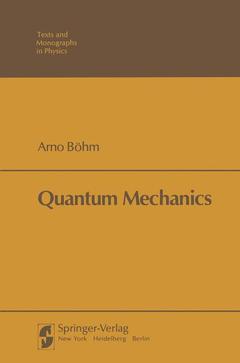Quantum Mechanics, Softcover reprint of the original 1st ed. 1979 Texts and Monographs in Physics Series
Langue : Anglais
Auteur : BOEHM

This book was written as a text, although many may consider it a mono graph. As a text it has been used several times in both the one-year graduate quantum-mechanics course and (in its shortened version) in a senior quantum mechanics course that I taught at the University of Texas at Austin. It is self-contained and does not require any prior knowledge of quantum mechanics. It also introduces the mathematical language of quantum mechanics, starting with the definitions, and attempts to teach this language by using it. Therefore, it can, in principle, be read without prior knowledge of the theory of linear operators and linear spaces, though some familiarity with linear algebra would be helpful. Prerequisites are knowledge of calculus and of vector algebra and analysis. Also used in a few places are some elementary facts of Fourier analysis and differential equations. Most physical examples are taken from the fields of atomic and molecular physics, as it is these fields that are best known to students at the stage when they learn quantum mechanics. This book may be considered a monograph because the presentation here is different from the usual treatment in many standard textbooks on quantum mechanics. It is not that a "different kind" of quantum mechanics is pre sented here; this is conventional quantum mechanics (" Copenhagen inter pretation ").
I Mathematical Preliminaries.- I.1 The Mathematical Language of Quantum Mechanics.- I.2 Linear Spaces, Scalar Product.- I.3 Linear Operators, Algebras.- II Foundations of Quantum Mechanics — The Harmonic Oscillator.- II. 1 Introduction.- II.2 The First Basic Assumption of Quantum Mechanics.- II.3 Algebra of the Harmonic Oscillator.- II.4 The Relation between Experimental Data and Quantum-Mechanical Observables.- II.5 The Effect of a Measurement on the State of a Quantum-Mechanical System.- II.6 The Basic Assumptions Applied to the Harmonic Oscillator, and Some Historical Remarks.- II.7 Some General Consequences of the Basic Assumptions of Quantum Mechanics.- II.8 Eigenvectors of Position and Momentum Operators; the Wave Functions of the Harmonic Oscillator.- II.9 Comparison between Quantum and Classical Harmonic Oscillators.- II.10 Basic Assumptions II and III for Observables with Continuous Spectra.- II.11 Position and Momentum Measurements—Particles and Waves.- III Energy Spectra of Some Molecules.- III.1 Transitions between Energy Levels of Vibrating Molecules—The Limitations of the Oscillator Model.- III.2 The Rigid Rotator.- III.3 The Algebra of Angular Momentum.- III.4 Rotation Spectra.- III.5 Combination of Quantum Physical Systems—The Vibrating Rotator.- IV Complete Systems of Commuting Observables.- V Addition of Angular Momenta — The Wigner — Eckart Theorem.- V.1 Introduction—The Elementary Rotator.- V.2 Combination of Elementary Rotators.- V.3 Tensor Operators and the Wigner-Eckart Theorem.- V.4 Parity.- VI Hydrogen Atom — The Quantum-Mechanical Kepler Problem.- VI.1 Introduction.- VI.2 Classical Kepler Problem.- VI.3 Quantum-Mechanical Kepler Problem.- VI.4 Properties of the Algebra of Angular Momentum and the Lenz Vector.- VI.5 The Hydrogen Spectrum.- VII Alkali Atoms and the Schrödinger Equation of One-Electron Atoms.- VII.1 The Alkali Hamiltonian and Perturbation Theory.- VII.2 Calculation of the Matrix Elements of the Operator Q?v.- VII.3 Wavefunctions and Schrödinger Equation of the Hydrogen Atom and the Alkali Atoms.- VIII Perturbation Theory.- VIII.1 Perturbation of the Discrete Spectrum.- VIII.2 Perturbation of the Continuous Spectrum—The Lippman-Schwinger Equation.- IX Electron Spin.- IX.1 Introduction.- IX.2 The Fine Structure—Qualitative Considerations.- IX.3 Fine-Structure Interaction.- IX.4 Fine Structure of Atomic Spectra.- IX.5 Selection Rules.- IX.6 Remarks on the State of an Electron in Atoms.- X Indistinguishable Particles.- X.1 Introduction.- XI Two-Electron Systems — The Helium Atom.- XI.1 The Two Antisymmetric Subspaces of the Helium Atom.- XI.2 Discrete Energy Levels of Helium.- XI.3 Selection Rules and Singlet-Triplet Mixing for the Helium Atom.- XI.4 Doubly Excited States of Helium.- XII Time Evolution.- XII.1 Time Evolution.- XII.A Mathematical Appendix: Definitions and Properties of Operators That Depend upon a Parameter.- XIII Change of the State by Dynamical Law and by the Measuring Process — The Stern — Gerlach Experiment.- XIII.1 The Stern-Gerlach Experiment.- XIII.A Appendix.- XIV Transitions in Quantum Physical Systems — Cross Section.- XIV.1 Introduction.- XIV.2 Transition Probabilities and Transition Rates.- XIV.3 Cross Sections.- XIV.4 The Relation of Cross Sections to the Fundamental Physical Observables.- XIV.5 Derivation of Cross-Section Formulas for the Scattering of a Beam off a Fixed Target.- XV Formal Scattering Theory and Other Theoretical Considerations.- XV.1 The Lippman-Schwinger Equation.- XV.2 In-States and Out-States.- XV.3 The S-Operator and the Møller Wave Operators.- XV.A Appendix.- XVI Elastic and Inelastic Scattering for Spherically Symmetric Interactions.- XVI.1 Partial-Wave Expansion.- XVI.2 Unitarity and Phase Shifts.- XVI.3 Argand Diagrams.- XVII Free and Exact Radial Wave Functions.- XVII.1 Introduction.- XVII.2 The Radial Wave Equation.- XVII.3 The Free Radial Wave Function.- XVII.4 The Exact Radial Wave Function.- XVII.5 Poles and Bound States.- XVII.6 Survey of Some General Properties of Scattering Amplitudes and Phase Shifts.- XVII.A Mathematical Appendix.- XVIII Resonance Phenomena.- XVIII.1 Introduction.- XVIII.2 Time Delay and Phase Shifts.- XVIII.3 Causality Conditions.- XVIII.4 Causality and Analyticity.- XVIII.5 Brief Description of the Analyticity Properties of the S-Matrix.- XVIII.6 Resonance Scattering—Breit-Wigner Formula for Elastic Scattering.- XVIII.7 The Physical Effect of a Virtual State.- XVIII.8 Argand Diagrams for Elastic Resonances and Phase-Shift Analysis.- XVIII.9 Comparison with the Observed Cross Section: the Effect of Background and Finite Energy Resolution.- XIX Time Reversal.- XIX.1 Space-Inversion Invariance and the Properties of the S-Matrix.- XIX.2 Time Reversal.- XIX.2 Appendix to Section XIX.2.- XIX.3 Time-Reversal Invariance and the Properties of the S-Matrix.- XX Resonances in Multichannel Systems.- XX.1 Introduction.- XX.2 Single and Double Resonances.- XX.3 Argand Diagrams for Inelastic Resonances.- XXI The Decay of Unstable Physical Systems.- XXI.1 Introduction.- XXI.2 Lifetime and Decay Rate.- XXI.3 The Description of a Decaying State and the Exponential Decay Law.- XXI.4 Decay Rate.- XXI.5 Partial Decay Rates.- Epilogue.
Date de parution : 11-2011
Ouvrage de 522 p.
15.5x23.5 cm
Disponible chez l'éditeur (délai d'approvisionnement : 15 jours).
Prix indicatif 52,74 €
Ajouter au panier
© 2024 LAVOISIER S.A.S.



